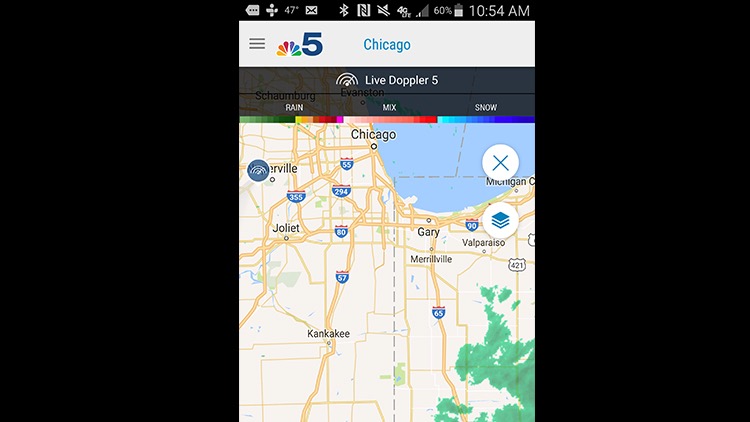NBC, Telemundo Put Radar in Viewers’ Hands

The NBCUniversal station group is giving you one less reason to blame the weather guy when you get wet.
Since March, the broadcast group has offered live feeds from three radars—the stations’ fixed and mobile radars, and the National Weather Service’s—in all the NBC and Telemundo-owned station apps.
Now users, rather than relying on just the experts, can do a little weather watching on their own—using the station radar feeds for what’s going on locally (down to their own neighborhoods) and the weather service feed to get the bigger picture.
Mastering reading the radar feeds (let alone interpreting them) takes a bit of hands-on practice.
Users can zoom in to pinpoint their neighborhoods using their hometown station’s radar feeds, or one being sent by one of the group’s mobile StormRangers, basically a weather center on wheels. Zooming out gets you a snapshot of the entire country with an overlay of color-coded masses of precipitation—green for rain, blue for snow and shades of red for everything in between.
A time-lapse feature allows users to see which way the storm has been blowing over the last hour—and whether it’s heading their way.
NBC’s live radar offering is the first of its kind, in that it allows users to view all three radar feeds layered on each other, providing a comprehensive feed, says Bill Dow, VP and general manager of The Weather Company, which developed the technology.
Broadcasting & Cable Newsletter
The smarter way to stay on top of broadcasting and cable industry. Sign up below
While National Weather Service and other radar feeds are available on a range of platforms, NBC’s offering marks the first time a broadcaster has layered images from multiple sources, Dow said.
“Integrating all the radar data into a layer on the map means the user doesn’t have to think about which [radar feed] to select,” he said. Users automatically get the best information from the best radar depending on where they are focusing their search, he said.
Weather and tech fans may find playing around with that titillating enough in its own right.
But Rick Mitchell, a meteorologist at NBC-owned KXAS Dallas-Fort Worth, said that live radar feeds have far more value than being just a cool new toy.
“Let’s face it. Some of what television has become over the years is bells and whistles,” Mitchell said. “This is not. This truly can be lifesaving information we’re giving out.”
That’s particularly true, he said, during severe weather—hurricanes and tornadoes, for example—during which users can use the radar to pinpoint when and where the storm will hit, even from a TV-free space like a storm shelter or car. The radar feed is even more potent when used in conjunction with other mobile features, such as weather alerts in English and Spanish, and live streams, he said.
Brant Miller, a meteorologist at WMAQ, the NBC O&O in Chicago, said the users also benefit from the group’s recent investment in improving the radars themselves. In weather heavy New York, Chicago, Dallas and Miami, that includes purchasing high frequency S-band radars, which allow meteorologists to look through bands of storms to see what’s beyond the most immediate, Miller said. The group’s three StormRangers (that’s Caza-Tormentas in Spanish) carry X-band radars around the country that can pick up the localized activity that fixed radars can miss, he said.
Although the technology is next-gen sophisticated, Miller said he believes consumers are ready to use it, whether it’s to determine whether a Cubs game is going to be rain-delayed or a storm is getting dangerously close. “Every day the audience gets more and more sophisticated,” he said.
It’s also what people want, said Weather Company’s Dow. “We know that checking weather is a daily habit,” Dow said. Weather Company research shows 83% of consumers check forecasts at least once a day; additionally, 74% think having severe weather information available through an app is an important thing, he said.
Lora Dennis, the group’s senior VP of digital media, said adding the live radar feed to the station apps, which was in the works for roughly nine months, is part of NBC’s larger ongoing investment in ramping up its stations’ weather offerings on digital as well as on-air.
“We have the benefit of providing valuable information,” she said. “We want to provide the same level of that across platforms.”
Miller said it’s also the right thing to do. “My goal is to make people safe by giving them the information,” he said.










